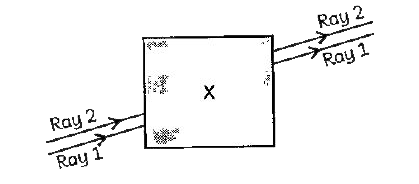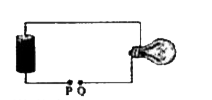Meenu sets up an electric circuit as shown in the figure by usingg copper wire. She repeated the experiment with:
Aluminium foil, Iron nail,
Coal, Graphite
In which cases the bulb will light up ?

I and II only
II and IV only
I, II and IV
I,II,III and IV
The correct Answer is:C
Aluminium and iron are metals and metals are good conductors of electricity, thus the bulb will light up. Coal and graphite are non-metals and non-metals do not conduct electricity but graphite is an exception and it conducts electricity.
Topper's Solved these Questions
- BOOK - MTG IIT JEE FOUNDATIONCHAPTER - MATERIALS : METALS AND NON-METALSEXERCISE - EXERCISE (Match the Following)5videos
MATERIALS : METALS AND NON-METALS
- BOOK - MTG IIT JEE FOUNDATIONCHAPTER - MATERIALS : METALS AND NON-METALSEXERCISE - EXERCISE (Assertion & Reason Type)10videos
MATERIALS : METALS AND NON-METALS
- BOOK - MTG IIT JEE FOUNDATIONCHAPTER - MATERIALS : METALS AND NON-METALSEXERCISE - EXERCISE MCQ.s (Level-1)30videos
MATERIALS : METALS AND NON-METALS
- BOOK - MTG IIT JEE FOUNDATIONCHAPTER - FOOTSTEPS towards(CBSE Board)EXERCISE - SECTION - D14videos
FOOTSTEPS towards(CBSE Board)
- BOOK - MTG IIT JEE FOUNDATIONCHAPTER - MATTER : ELEMENTS COMPOUNDS AND MIXTURES EXERCISE - EXERCISE (INTEGER/NUMERICAL VALUE )5videos
MATTER : ELEMENTS COMPOUNDS AND MIXTURES
Similar Questions
Brad sets up an electrical circuit as shown in the figure. He connects points P and Q of the circuit with four different rods made of four different materials - glass, wood, copper, and asbestos.

The bulb in the circuit will not light up when points P and Q are connected withView SolutionBrad sets up an electrical circuit as shown in the given figure. He connects points P and Q of the circuit with four different rods made of four different materials - glass, wood, copper, and asbestos.

The bulb in the circuit will not light up when points P and Q are connected withView Solution
Knowledge Check
- Question 1 - Select One
Amrita is trying to set-up an electric circuit. She runs short of connecting wires. Which of the following materials can she use to complete the circuit ?
ARubber pipeBThick threadCSteel wireDGlass rod - Question 2 - Select One
Case : Noor, a young student, was trying to demonstrate some properties of light in her Science project work. She kept 'X' inside the box (as shown in the figure) and with the help of a laser pointer made light rays pass through the holes on one side of the box. She had a small butter-paper screen to see the spots of light being cast as they emerged.

Her friend noted the following observations from this demonstration:
(I) Glass is optically rarer than air.
(II) Air and glass allow light to pass through them with the same velocity.
(III) Air is optically rarer than glass.
(IV) Speed of light through a denser medium is faster than that of a rarer medium.
(V) The ratio: sin of angle of incidence in the first medium to the ratio of sin of angle of refraction in the second medium, gives the refractive index of the second material with respect to the first one.
Which one of the combination of the above statements given below is correct.A(II), (IV) and (V) are correctB(III) and (IV) are correctC(I), (IV) and (V) are correctD(III) and (V) are correct.
Tommy sets up an electrical circuit as shown in the figure. He connects points P and Q with different materials.

The bulb will light up when points P and Q are connected by a plate made ofView SolutionTommy sets up an electrical circuit as shown in the figure. He connects points P and Q with different materials.

The bulb will light up when points P and Q are connected by a plate made ofView SolutionMason constructs the circuit shown in the figure. He leaves a gap in the circuit to test the conductivity of various materials.

On inserting which of the following materials in the gap will the bulb not light up?View SolutionMason constructs the circuit shown in the figure. He leaves a gap in the circuit to test the conductivity of various materials.

On inserting which of the following materials in the gap will the bulb not light up?View SolutionMake a simple electirc circuit using three copper wires, a bulb and a battery as shown in the figure given alongside. Now, collect the following items-an iron nail, a copper key, a strip of aluminium foil and a piece of coal. Place each of the collected items, one by one, between the points A and B such that the circuit is closed. Read the questions below and try to answer them

What do you understand from this activity?View SolutionRahu, is studying in clas X whereas his younger brother Mohan is a student of clas VI. Mohan has been asked by his teacher to make a working model to show that some non-metal can also be a good conductor of electricity. Mohan has already made an electric circuit by using a dry cell whose both the terminals are connected to two long copper wires having crocodile clips attached to their ends, and one of the copper wires has a torch bulb connected in it through a bulb holder. Mohan, however failked to get a non-metal which could conduct electricity. Mohan asked his brother for help. Rahul told Mohan to take a pencil, sharpen this pencil at both ends, and then connect it in the circuit made by him attaching the two crocodile clips at its two ends. Mohan did the same. As soon as the pencil sharpened at both ends was connected in the circuit the torch bulb started glowing.
(a) Of what substance is theblack core of pencil made? What does the glowing of bulb in this activity indicate?
(b) Name the element of which the above substance is anallotrope?
(c) Which allotrope of this element:
(i) is used in glass cutters?
(ii) is used in luibricating oils?
(iii) has a spherical molecule made up of 60 atoms?
(d) Name two properties of this element due to which it forms a large number of compounds.
(e) Name one compound each of this element which is used:
(i) as a solvent.
(ii) to ripen raw fruits
(iii) to preserve are displayed by Rahul in this episode?View Solution

